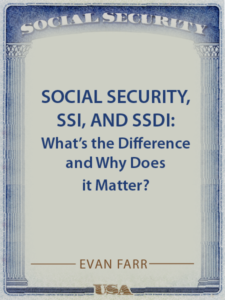Both SSI and SSDI offer cash benefits for persons with disabilities. Both programs are overseen and managed by the Social Security Administration. Medical eligibility for disability is determined in the same manner for both programs. However the eligibility requirements are quite different, attorney involvement in eligibility is quite different, and the need for a disabled recipient of these benefits to receive an inheritance protected by a special needs trust is completely different, depending on which of these two benefits is being received. Some people receive both SSI and SSDI, but this is rare. The most significant difference between Social Security Disability Income (SSDI) and Supplemental Security Income (SSI) is the fact that SSDI is only available to workers who have accumulated a sufficient number of work credits, while SSI benefits are primarily for low-income individuals who have either never worked or who haven’t earned enough work credits to qualify for SSDI.
What is SSI?
Supplemental Security Income is a program that is needs-based, for disabled persons with very low income and almost no assets. SSI is funded by general fund taxes (not from the Social Security trust fund). SSI is called a “means-tested program,” meaning it has nothing to do with work history, but strictly with financial need. The maximum benefit paid by SSI in 2020 was $783 per month for individuals and $1,175 for couples (this increases annually if there is a Social Security cost-of-living adjustment).
Many disabled clients and family members of disabled clients don’t know if they’re receiving SSI or SSDI; all they know is they get a check from Social Security. A good way to determine is to ask them the amount of the check. If it’s an individual and he or she is receiving $783 or roughly two-thirds of that amount, it’s a pretty safe bet that person is on SSI. If it’s a married couple receiving a total of $1,175 per month, it’s a pretty safe bet that both of them are getting SSI.
To meet the SSI income requirements, a disabled person must have less than $2,000 in assets (or $3,000 for a married couple) and a very limited income. In many states, a person with a disability who is eligible under the income requirements for SSI is also able to receive Medicaid. Most people who qualify for SSI will also qualify for food stamps, and the amount an eligible person will receive is dependent on where they live and the amount of regular, monthly income they receive.
The Practical Lawyer

CLICK HERE for the free download of the full article, which was originally published in ALI CLE’s The Practical Lawyer.
Subscribe to the print or digital version of The Practical Lawyer today.

